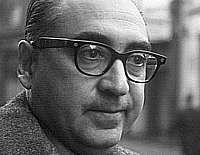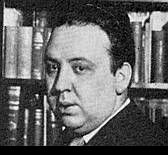

Saul Bass and Alfred Hitchcock
genius vs. the mediocre



by Dan Auiler
correct me if I'm wrong

There are so many fine visuals in this movie that it made me jump to the conclusion that, somehow, Saul Bass had his hand in it. Well, I was wrong, as Stefan Blau assures me - and he ought to know. Examples: There is a most weird shot, when James Stewart for the second time kisses Kim Novak for the first time. The camera dollies around the couple in a hotel room, and behind them we see the setting of their first first kiss. It may have been done with a revolving plateau for the actors and rear projection or a moving matte/bluescreen. And the music!
I had my suspicions about several other details. The light that keeps diminishing in the bookshop. The wave crashing behind an embrace. A cloud of pigeons coming by at exactly the right moment. All of these, I graciously and even happily concede, could very well have been thought of by Hitch or his screenplay writer. There are just so many of them.
The nightmare has been done by John Ferren.
—and (in a desperate struggle to keep it clean) where I hit the spot.
To be sure, Dan Auiler put a lot of effort into his book. My nag is that, somehow, all those books seem to get researched and written by people who can't have an inkling of how movies are actually made. Of course, there are many different ways to go about movie production (it shows, too); this is not what I mean. But every now and then you stumble your toes on items that just can't be true.
The effect of this, unavoidably, is that you mistrust all information offered.
Some examples:
| VistaVision |
| After first referring to this as a "color system", Auiler finally gets it right: it's a wide screen system. Then he goes completely of the tracks again. You can only hope that restorers James C. Katz and Robert A. Harris did tell him something else than, as he quotes on page 200, "it went on 70mm, exactly the size of VistaVision. We didn't blow up or reduce it." Now VistaVision (sparing you many nitty-gritty details) has a negative size of 37.7*25.2mm with an aspect ratio of 1.50:1 - exactly a 35mm 'miniature' still camera like Contax or Leica, nominally 24*36mm (there always is a cut-off when projecting or printing). This was optically reduced to a standard 35mm 4 perforation pulldown copy with a projector aperture of 21.0*11.4 mm (ratio 1.85:1). However, a 70mm print has a projector aperture of 48.6*22.1 mm (ratio 2.2:1) and it's unclear how anybody would figure that's 'exactly' the same size. (Maybe because they figure in inches... yeah, could very well be. Highly confusing.) What can you do but hope for the best? But if those guys have indeed said this, they are nitwits and I would have found them out while talking to them. What I do suspect is that another guy is the nitwit here, and it's not me. Later on, Auiler remarks that there were VistaVision 'anamorphic' prints; which are not mentioned in my trusty 1960 American Cinematographer Manual, and also not on the Wide Screen Museum site. (They do "seem" to have been around, though, in Italy.) Auiler has a final chapter on VistaVision (page 211) in which he states that CinemaScope lenses are expensive and that they have a reduced depth of focus. Consider the fact that VistaVision uses twice the amount of negative film (plus processing and printing) and you'll agree that you'd earn back that lens rent in a jiffy. It couldn't have been that expensive. Matter of fact, one of the main advantages of CinemaScope was, you used your crummy old equipment and put a Bausch & Lomb lens in front, and you were in business. Can't beat it. Then, we're at it anyway, 20th Century Fox top cinematographer Leon Shamroy actually wrote that the depth of focus was increased, which sounds pretty logical - theoretically, the focal length is reduced, if only horizontally, by half; which just must result in some advantage. On the other hand, as VistaVision uses [35mm still camera] lenses with twice the film standard focal length, the depth of focus is reduced there. Wrong again, Auiler. |
| The Vertigo Shots |
| Nobody seems to remember where this idea came from. Even Hitchcock did not claim credit for it, although he did claim to François Truffaut it was he, The Great HitchPrick Himself, who thought of doing it in miniature. This is contradicted by John Fulton, who spent time with Irving Roberts "convincing Hitchcock" that it would cost only $2000 that way, 10% of the full-scale price. Auiler repeats the same mistake at least twice and he never gets it right: He describes it was done by zooming in while tracking out ("reverse-track forward-zoom"). Do me a favor, take out your camera and check this for yourself; saves me a lot of typing. It's the other way around; pure nonsense by somebody who doesn't know the first thing about zoom lenses. The one thing I learned is that they built the models horizontally, just like Ub Iwerks' multiplane animation camera. Much easier to control. I did find out (not from Auiler) that VistaVision used a 60-240mm Berthiot Pan-Cinor Zoom; that's a range of 1:4, from slightly longer than standard to tele. |
I hope I've made my point:
you have to double-check every single thing you read in this book.
About Saul Bass
Auiler did interview Saul Bass; it's all about the titles. Not a word about those effects that made me suspect he may have inspired them. Auiler does manage to get yet another mistake in, referring to the "stationary typography" and "unobtrusive movement", never seeming to notice the powerful motion of both main title "VERTIGO" and "directed by ALFRED HITCHCOCK". By now, you wonder why a man like that would want to write on movies. At least, I bought his book to make sure I didn't write such rubbish!
Anyway, that settles it. I may still have my suspicions, but there's no way to prove anything one way or the other.
| Movies | the most complete list of Saul Bass' movie work around dates, directors, alphabetical listing, posters, ads, record sleeves, book designs - the works |
| Logos & Trademarks | some of these may surprise you |
| More Movie Graphics | honor where honor is due: more good artists in this field |
| Screen Aspect Ratios | how you hardly ever see a movie as it was meant to be seen |
| Bass Business Bust | how the Dutch never got to see The Searching Eye |
| Bass Books | Books on, about and by Bass |




SEARCH this site or the Web

copyright notice
all material on this site, except where noted
copyright © by harrie verstappen , curaçao
reproduction in any form for any purpose is prohibited
without prior consent in writing